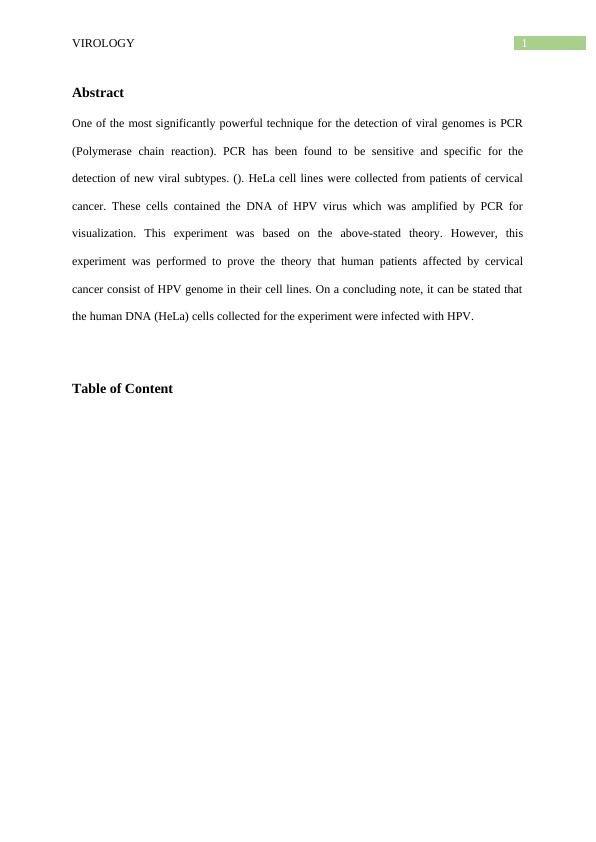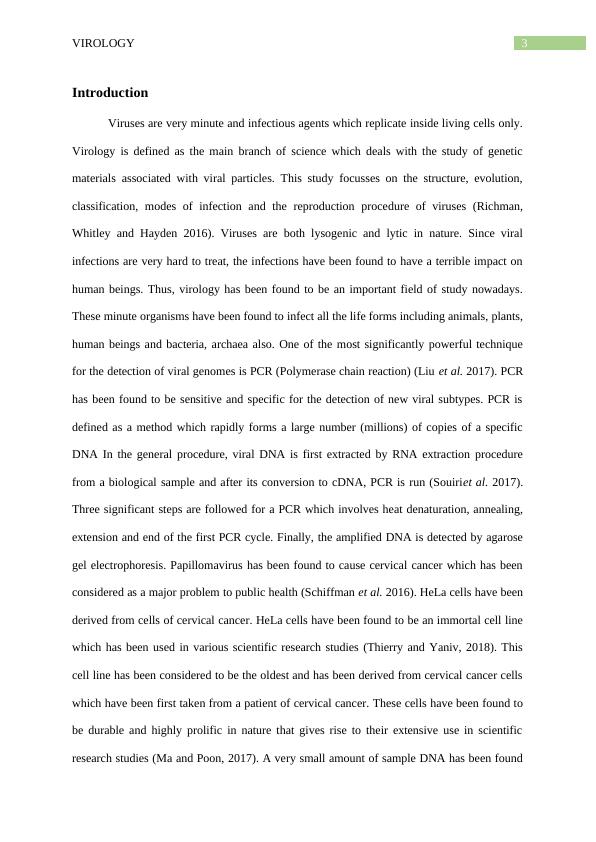Virology - Microbiology, Immunology and Molecular Genetics
Added on 2022-08-21
11 Pages2156 Words17 Views
Running head: VIROLOGY
PCR AND AGAROSE GEL ELECTROPHORESIS (VIRUS)
Name of the Student
Name of the University
Author Note
PCR AND AGAROSE GEL ELECTROPHORESIS (VIRUS)
Name of the Student
Name of the University
Author Note

1VIROLOGY
Abstract
One of the most significantly powerful technique for the detection of viral genomes is PCR
(Polymerase chain reaction). PCR has been found to be sensitive and specific for the
detection of new viral subtypes. (). HeLa cell lines were collected from patients of cervical
cancer. These cells contained the DNA of HPV virus which was amplified by PCR for
visualization. This experiment was based on the above-stated theory. However, this
experiment was performed to prove the theory that human patients affected by cervical
cancer consist of HPV genome in their cell lines. On a concluding note, it can be stated that
the human DNA (HeLa) cells collected for the experiment were infected with HPV.
Table of Content
Abstract
One of the most significantly powerful technique for the detection of viral genomes is PCR
(Polymerase chain reaction). PCR has been found to be sensitive and specific for the
detection of new viral subtypes. (). HeLa cell lines were collected from patients of cervical
cancer. These cells contained the DNA of HPV virus which was amplified by PCR for
visualization. This experiment was based on the above-stated theory. However, this
experiment was performed to prove the theory that human patients affected by cervical
cancer consist of HPV genome in their cell lines. On a concluding note, it can be stated that
the human DNA (HeLa) cells collected for the experiment were infected with HPV.
Table of Content

2VIROLOGY
s
Introduction................................................................................................................................3
Methods......................................................................................................................................4
Part 1 (PCR)...........................................................................................................................4
Part 2 (Agarose gel electrophoresis)......................................................................................4
Results........................................................................................................................................5
Discussion..................................................................................................................................6
Conclusion..................................................................................................................................7
References..................................................................................................................................8
s
Introduction................................................................................................................................3
Methods......................................................................................................................................4
Part 1 (PCR)...........................................................................................................................4
Part 2 (Agarose gel electrophoresis)......................................................................................4
Results........................................................................................................................................5
Discussion..................................................................................................................................6
Conclusion..................................................................................................................................7
References..................................................................................................................................8

3VIROLOGY
Introduction
Viruses are very minute and infectious agents which replicate inside living cells only.
Virology is defined as the main branch of science which deals with the study of genetic
materials associated with viral particles. This study focusses on the structure, evolution,
classification, modes of infection and the reproduction procedure of viruses (Richman,
Whitley and Hayden 2016). Viruses are both lysogenic and lytic in nature. Since viral
infections are very hard to treat, the infections have been found to have a terrible impact on
human beings. Thus, virology has been found to be an important field of study nowadays.
These minute organisms have been found to infect all the life forms including animals, plants,
human beings and bacteria, archaea also. One of the most significantly powerful technique
for the detection of viral genomes is PCR (Polymerase chain reaction) (Liu et al. 2017). PCR
has been found to be sensitive and specific for the detection of new viral subtypes. PCR is
defined as a method which rapidly forms a large number (millions) of copies of a specific
DNA In the general procedure, viral DNA is first extracted by RNA extraction procedure
from a biological sample and after its conversion to cDNA, PCR is run (Souiriet al. 2017).
Three significant steps are followed for a PCR which involves heat denaturation, annealing,
extension and end of the first PCR cycle. Finally, the amplified DNA is detected by agarose
gel electrophoresis. Papillomavirus has been found to cause cervical cancer which has been
considered as a major problem to public health (Schiffman et al. 2016). HeLa cells have been
derived from cells of cervical cancer. HeLa cells have been found to be an immortal cell line
which has been used in various scientific research studies (Thierry and Yaniv, 2018). This
cell line has been considered to be the oldest and has been derived from cervical cancer cells
which have been first taken from a patient of cervical cancer. These cells have been found to
be durable and highly prolific in nature that gives rise to their extensive use in scientific
research studies (Ma and Poon, 2017). A very small amount of sample DNA has been found
Introduction
Viruses are very minute and infectious agents which replicate inside living cells only.
Virology is defined as the main branch of science which deals with the study of genetic
materials associated with viral particles. This study focusses on the structure, evolution,
classification, modes of infection and the reproduction procedure of viruses (Richman,
Whitley and Hayden 2016). Viruses are both lysogenic and lytic in nature. Since viral
infections are very hard to treat, the infections have been found to have a terrible impact on
human beings. Thus, virology has been found to be an important field of study nowadays.
These minute organisms have been found to infect all the life forms including animals, plants,
human beings and bacteria, archaea also. One of the most significantly powerful technique
for the detection of viral genomes is PCR (Polymerase chain reaction) (Liu et al. 2017). PCR
has been found to be sensitive and specific for the detection of new viral subtypes. PCR is
defined as a method which rapidly forms a large number (millions) of copies of a specific
DNA In the general procedure, viral DNA is first extracted by RNA extraction procedure
from a biological sample and after its conversion to cDNA, PCR is run (Souiriet al. 2017).
Three significant steps are followed for a PCR which involves heat denaturation, annealing,
extension and end of the first PCR cycle. Finally, the amplified DNA is detected by agarose
gel electrophoresis. Papillomavirus has been found to cause cervical cancer which has been
considered as a major problem to public health (Schiffman et al. 2016). HeLa cells have been
derived from cells of cervical cancer. HeLa cells have been found to be an immortal cell line
which has been used in various scientific research studies (Thierry and Yaniv, 2018). This
cell line has been considered to be the oldest and has been derived from cervical cancer cells
which have been first taken from a patient of cervical cancer. These cells have been found to
be durable and highly prolific in nature that gives rise to their extensive use in scientific
research studies (Ma and Poon, 2017). A very small amount of sample DNA has been found

End of preview
Want to access all the pages? Upload your documents or become a member.
Related Documents
Gene Amplification Testing hela Levellg...
|6
|1310
|51
What Is a Case Study? | Examples & Methodslg...
|5
|698
|17
Pathophysiology of cervical cancerlg...
|3
|686
|31
Ebola Virus Disease Report 2022lg...
|2
|1321
|33
Herpes Simplex Viruslg...
|2
|1337
|330
The History, Ethics, and Impact of HeLa Cells on Cancer Researchlg...
|8
|2627
|309